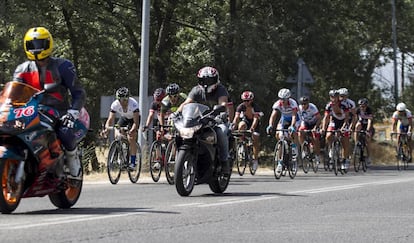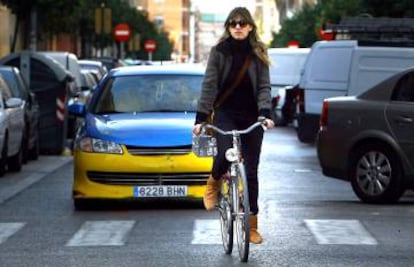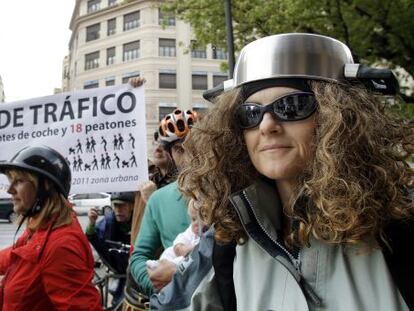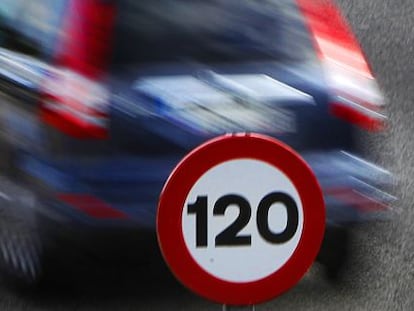Rules for cycling safe in Spain
Cyclists are at greatest risk on country roads, where frustrated drivers overtake at inopportune moments

Cycling is becoming increasingly popular in Spain. One need only glance at the sector’s sales figures to see that this is true: 2015 saw €662 million worth of cycling equipment sold, up by €68 million from the previous year and €112 million more than in 2013, according to the Association of Spanish Brands and Bicycles (Ambe)’s annual report.
However frustrated a driver may be feeling, he or she needs to remember how vulnerable a cyclist is
José Almagro, Madrid Cycling Federation
But it is not only the sales figures that reflect the boom. There has also been a simultaneous rise in accidents. According to the latest figures from the DGT national traffic authority, accidents in the Madrid region rose from 592 accidents in 2011 (57 seriously injured and three fatalities) to 915 in 2014 (81 seriously injured and three dead).
And though most accidents happen within city limits, the worst ones take place on the roads in between cities and towns.
“A bike is not a toy. It is a vehicle that can reach significant speeds, and some people go off on the road without being aware of their own rights and obligations,” says José Almagro, secretary general of the Madrid Cycling Federation.
Many websites, such as the ones run by the RACE automobile association or by the DGT, offer safety tips for cyclists.
The most basic rule is to respect the law and wear a helmet outside city limits (it is not mandatory on urban roads).
Two cyclists may ride abreast as long as they stay as far to the right of the road as possible, except on stretches with poor visibility or when traffic is dense. Cars, for their part, must observe a side distance of 1.5m when overtaking cyclists.
The rule of thumb to remember is that bicycles are vehicles and cyclists need to respect the traffic rules just like drivers do. They do, however, have priority when cycling in a group and the first cyclist has already started to cross an intersection or entered a roundabout.

But this becomes difficult when cyclists ride in large groups, a common practice on main roads in the Sierra de Madrid, where few cyclists bother to keep to the side of the road. The result is that some drivers lose their patience and overtake at dangerous times, while others form long lines while they wait for a safe moment to overtake, making it dangerous for other vehicles coming up behind on a blind corner.
“However frustrated a driver may be feeling, he or she needs to remember how vulnerable a cyclist is,” says Almagro. “It’s all about being patient, using your common sense and obeying rules that are there for a reason,” adds Alfonso Triviño, secretary general of the Association for Professional Cyclists and a legal specialist in road safety.
In Almagro’s opinion, there can never be too many awareness campaigns.
Last year, there were 11 serious accidents on Madrid’s roads, resulting in three fatalities. So far in 2016 there have been four serious injuries and two dead. In Soto del Real, a banner on the M-608 has been raised in memory of one of the fatalities.
English version by Heather Galloway.
Tu suscripción se está usando en otro dispositivo
¿Quieres añadir otro usuario a tu suscripción?
Si continúas leyendo en este dispositivo, no se podrá leer en el otro.
FlechaTu suscripción se está usando en otro dispositivo y solo puedes acceder a EL PAÍS desde un dispositivo a la vez.
Si quieres compartir tu cuenta, cambia tu suscripción a la modalidad Premium, así podrás añadir otro usuario. Cada uno accederá con su propia cuenta de email, lo que os permitirá personalizar vuestra experiencia en EL PAÍS.
¿Tienes una suscripción de empresa? Accede aquí para contratar más cuentas.
En el caso de no saber quién está usando tu cuenta, te recomendamos cambiar tu contraseña aquí.
Si decides continuar compartiendo tu cuenta, este mensaje se mostrará en tu dispositivo y en el de la otra persona que está usando tu cuenta de forma indefinida, afectando a tu experiencia de lectura. Puedes consultar aquí los términos y condiciones de la suscripción digital.
More information
Últimas noticias
Most viewed
- Why we lost the habit of sleeping in two segments and how that changed our sense of time
- Trump’s obsession with putting his name on everything is unprecedented in the United States
- Pablo Escobar’s hippos: A serious environmental problem, 40 years on
- The Florida Keys tourist paradise is besieged by immigration agents: ‘We’ve never seen anything like this’
- Charles Dubouloz, mountaineering star, retires at 36 with a farewell tour inspired by Walter Bonatti











































